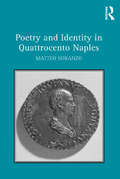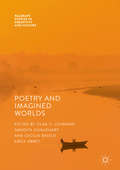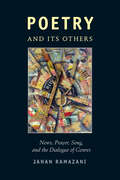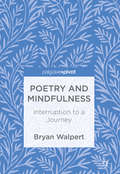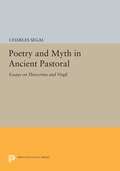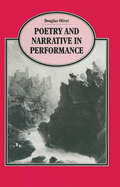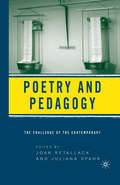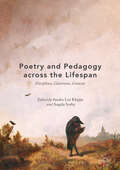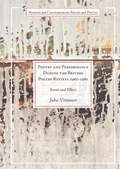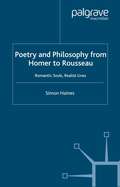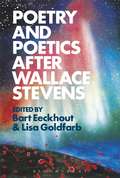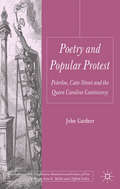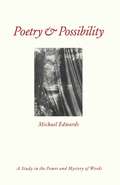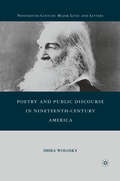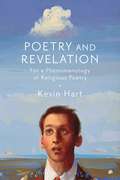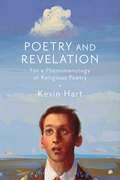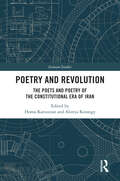- Table View
- List View
Poetry and Identity in Quattrocento Naples
by Matteo SoranzoPoetry and Identity in Quattrocento Naples approaches poems as acts of cultural identity and investigates how a group of authors used poetry to develop a poetic style, while also displaying their position toward the culture of others. Starting from an analysis of Giovanni Pontano’s Parthenopeus and De amore coniugali, followed by a discussion of Jacopo Sannazaro’s Arcadia, Matteo Soranzo links the genesis and themes of these texts to the social, political and intellectual vicissitudes of Naples under the domination of Kings Alfonso and Ferrante. Delving further into Pontano’s literary and astrological production, Soranzo illustrates the consolidation and eventual dispersion of this author’s legacy by looking at the symbolic value attached to his masterpiece Urania, and at the genesis of Sannazaro’s De partu Virginis. Poetic works written in neo-Latin and the vernacular during the Aragonese domination, in this way, are examined not only as literary texts, but also as the building blocks of their authors’ careers.
Poetry And Imagined Worlds
by Olga V. Lehmann Nandita Chaudhary Ana Cecilia Bastos Emily AbbeyThis book explores the deep, imaginative, and creative power of poetry as part of the human experience. How poetry provides insight into human psychology is a question at the beginning of its theoretical development, and is a constant challenge for cultural psychologists and the humanities alike. Poetry functions, in all ages and cultures, as a rite that merges the beauty, truth and the unbearable conditions of existence. Both the general and the particular can be found in its expression. Collectively the authors aim to evoke a holistic understanding of what poetry conveys about decision making and the human search for meaning. This ground-breaking collection will be indispensable to scholars of clinical and theoretical psychology, philosophy, anthropology, literature, aesthetics and sociology.
Poetry And Imagined Worlds
by Olga V. Lehmann Nandita Chaudhary Ana Cecilia Bastos Emily AbbeyThis book explores the deep, imaginative, and creative power of poetry as part of the human experience. How poetry provides insight into human psychology is a question at the beginning of its theoretical development, and is a constant challenge for cultural psychologists and the humanities alike. Poetry functions, in all ages and cultures, as a rite that merges the beauty, truth and the unbearable conditions of existence. Both the general and the particular can be found in its expression. Collectively the authors aim to evoke a holistic understanding of what poetry conveys about decision making and the human search for meaning. This ground-breaking collection will be indispensable to scholars of clinical and theoretical psychology, philosophy, anthropology, literature, aesthetics and sociology.
Poetry and Its Others: News, Prayer, Song, and the Dialogue of Genres
by Jahan RamazaniWhat is poetry? Often it is understood as a largely self-enclosed verbal system—“suspended from any mutual interaction with alien discourse,” in the words of Mikhail Bakhtin. But in Poetry and Its Others, Jahan Ramazani reveals modern and contemporary poetry’s animated dialogue with other genres and discourses. Poetry generates rich new possibilities, he argues, by absorbing and contending with its near verbal relatives. Exploring poetry’s vibrant exchanges with other forms of writing, Ramazani shows how poetry assimilates features of prose fiction but differentiates itself from novelistic realism; metabolizes aspects of theory and philosophy but refuses their abstract procedures; and recognizes itself in the verbal precision of the law even as it separates itself from the law’s rationalism. But poetry’s most frequent interlocutors, he demonstrates, are news, prayer, and song. Poets such as William Carlos Williams and W. H. Auden refashioned poetry to absorb the news while expanding its contexts; T. S. Eliot and Charles Wright drew on the intimacy of prayer though resisting its limits; and Paul Muldoon, Rae Armantrout, and Patience Agbabi have played with and against song lyrics and techniques. Encompassing a cultural and stylistic range of writing unsurpassed by other studies of poetry, Poetry and Its Others shows that we understand what poetry is by examining its interplay with what it is not.
Poetry and Its Others: News, Prayer, Song, and the Dialogue of Genres
by Jahan RamazaniWhat is poetry? Often it is understood as a largely self-enclosed verbal system—“suspended from any mutual interaction with alien discourse,” in the words of Mikhail Bakhtin. But in Poetry and Its Others, Jahan Ramazani reveals modern and contemporary poetry’s animated dialogue with other genres and discourses. Poetry generates rich new possibilities, he argues, by absorbing and contending with its near verbal relatives. Exploring poetry’s vibrant exchanges with other forms of writing, Ramazani shows how poetry assimilates features of prose fiction but differentiates itself from novelistic realism; metabolizes aspects of theory and philosophy but refuses their abstract procedures; and recognizes itself in the verbal precision of the law even as it separates itself from the law’s rationalism. But poetry’s most frequent interlocutors, he demonstrates, are news, prayer, and song. Poets such as William Carlos Williams and W. H. Auden refashioned poetry to absorb the news while expanding its contexts; T. S. Eliot and Charles Wright drew on the intimacy of prayer though resisting its limits; and Paul Muldoon, Rae Armantrout, and Patience Agbabi have played with and against song lyrics and techniques. Encompassing a cultural and stylistic range of writing unsurpassed by other studies of poetry, Poetry and Its Others shows that we understand what poetry is by examining its interplay with what it is not.
Poetry and Its Others: News, Prayer, Song, and the Dialogue of Genres
by Jahan RamazaniWhat is poetry? Often it is understood as a largely self-enclosed verbal system—“suspended from any mutual interaction with alien discourse,” in the words of Mikhail Bakhtin. But in Poetry and Its Others, Jahan Ramazani reveals modern and contemporary poetry’s animated dialogue with other genres and discourses. Poetry generates rich new possibilities, he argues, by absorbing and contending with its near verbal relatives. Exploring poetry’s vibrant exchanges with other forms of writing, Ramazani shows how poetry assimilates features of prose fiction but differentiates itself from novelistic realism; metabolizes aspects of theory and philosophy but refuses their abstract procedures; and recognizes itself in the verbal precision of the law even as it separates itself from the law’s rationalism. But poetry’s most frequent interlocutors, he demonstrates, are news, prayer, and song. Poets such as William Carlos Williams and W. H. Auden refashioned poetry to absorb the news while expanding its contexts; T. S. Eliot and Charles Wright drew on the intimacy of prayer though resisting its limits; and Paul Muldoon, Rae Armantrout, and Patience Agbabi have played with and against song lyrics and techniques. Encompassing a cultural and stylistic range of writing unsurpassed by other studies of poetry, Poetry and Its Others shows that we understand what poetry is by examining its interplay with what it is not.
Poetry and Its Others: News, Prayer, Song, and the Dialogue of Genres
by Jahan RamazaniWhat is poetry? Often it is understood as a largely self-enclosed verbal system—“suspended from any mutual interaction with alien discourse,” in the words of Mikhail Bakhtin. But in Poetry and Its Others, Jahan Ramazani reveals modern and contemporary poetry’s animated dialogue with other genres and discourses. Poetry generates rich new possibilities, he argues, by absorbing and contending with its near verbal relatives. Exploring poetry’s vibrant exchanges with other forms of writing, Ramazani shows how poetry assimilates features of prose fiction but differentiates itself from novelistic realism; metabolizes aspects of theory and philosophy but refuses their abstract procedures; and recognizes itself in the verbal precision of the law even as it separates itself from the law’s rationalism. But poetry’s most frequent interlocutors, he demonstrates, are news, prayer, and song. Poets such as William Carlos Williams and W. H. Auden refashioned poetry to absorb the news while expanding its contexts; T. S. Eliot and Charles Wright drew on the intimacy of prayer though resisting its limits; and Paul Muldoon, Rae Armantrout, and Patience Agbabi have played with and against song lyrics and techniques. Encompassing a cultural and stylistic range of writing unsurpassed by other studies of poetry, Poetry and Its Others shows that we understand what poetry is by examining its interplay with what it is not.
Poetry and Its Others: News, Prayer, Song, and the Dialogue of Genres
by Jahan RamazaniWhat is poetry? Often it is understood as a largely self-enclosed verbal system—“suspended from any mutual interaction with alien discourse,” in the words of Mikhail Bakhtin. But in Poetry and Its Others, Jahan Ramazani reveals modern and contemporary poetry’s animated dialogue with other genres and discourses. Poetry generates rich new possibilities, he argues, by absorbing and contending with its near verbal relatives. Exploring poetry’s vibrant exchanges with other forms of writing, Ramazani shows how poetry assimilates features of prose fiction but differentiates itself from novelistic realism; metabolizes aspects of theory and philosophy but refuses their abstract procedures; and recognizes itself in the verbal precision of the law even as it separates itself from the law’s rationalism. But poetry’s most frequent interlocutors, he demonstrates, are news, prayer, and song. Poets such as William Carlos Williams and W. H. Auden refashioned poetry to absorb the news while expanding its contexts; T. S. Eliot and Charles Wright drew on the intimacy of prayer though resisting its limits; and Paul Muldoon, Rae Armantrout, and Patience Agbabi have played with and against song lyrics and techniques. Encompassing a cultural and stylistic range of writing unsurpassed by other studies of poetry, Poetry and Its Others shows that we understand what poetry is by examining its interplay with what it is not.
Poetry and Its Others: News, Prayer, Song, and the Dialogue of Genres
by Jahan RamazaniWhat is poetry? Often it is understood as a largely self-enclosed verbal system—“suspended from any mutual interaction with alien discourse,” in the words of Mikhail Bakhtin. But in Poetry and Its Others, Jahan Ramazani reveals modern and contemporary poetry’s animated dialogue with other genres and discourses. Poetry generates rich new possibilities, he argues, by absorbing and contending with its near verbal relatives. Exploring poetry’s vibrant exchanges with other forms of writing, Ramazani shows how poetry assimilates features of prose fiction but differentiates itself from novelistic realism; metabolizes aspects of theory and philosophy but refuses their abstract procedures; and recognizes itself in the verbal precision of the law even as it separates itself from the law’s rationalism. But poetry’s most frequent interlocutors, he demonstrates, are news, prayer, and song. Poets such as William Carlos Williams and W. H. Auden refashioned poetry to absorb the news while expanding its contexts; T. S. Eliot and Charles Wright drew on the intimacy of prayer though resisting its limits; and Paul Muldoon, Rae Armantrout, and Patience Agbabi have played with and against song lyrics and techniques. Encompassing a cultural and stylistic range of writing unsurpassed by other studies of poetry, Poetry and Its Others shows that we understand what poetry is by examining its interplay with what it is not.
Poetry and Mindfulness: Interruption to a Journey
by Bryan WalpertAt a time when the Humanities are under threat, this book offers a defense of poetry within the context of growing interest in mindfulness in business, health care, and education. The book argues that the benefits and insights mindfulness provides are also cultivated by the study of poetry. These benefits include a focus on the present, the ability to see through scripts and habits, a rethinking of subjectivity, and the development of ecological or systems thinking. Bryan Walpert employs close readings of traditional and experimental poetry and draws on scientific studies of the effects of mindfulness or reading literature on the brain. It argues the skills that poetry, like mindfulness, cultivates are useful beyond the page or classroom and ultimately are necessary to engage with such global issues as the environmental crisis.
Poetry and Mindfulness: Interruption to a Journey
by Bryan WalpertAt a time when the Humanities are under threat, this book offers a defense of poetry within the context of growing interest in mindfulness in business, health care, and education. The book argues that the benefits and insights mindfulness provides are also cultivated by the study of poetry. These benefits include a focus on the present, the ability to see through scripts and habits, a rethinking of subjectivity, and the development of ecological or systems thinking. Bryan Walpert employs close readings of traditional and experimental poetry and draws on scientific studies of the effects of mindfulness or reading literature on the brain. It argues the skills that poetry, like mindfulness, cultivates are useful beyond the page or classroom and ultimately are necessary to engage with such global issues as the environmental crisis.
Poetry and Myth in Ancient Pastoral: Essays on Theocritus and Virgil
by Charles SegalCollected in this volume are fifteen essays, previously published in a wide variety of journals, on the pastoral poetry of Theocritus and Virgil.Originally published in 1981.The Princeton Legacy Library uses the latest print-on-demand technology to again make available previously out-of-print books from the distinguished backlist of Princeton University Press. These editions preserve the original texts of these important books while presenting them in durable paperback and hardcover editions. The goal of the Princeton Legacy Library is to vastly increase access to the rich scholarly heritage found in the thousands of books published by Princeton University Press since its founding in 1905.
Poetry and Narrative in Performance (Language, Discourse, Society)
by Douglas OliverThis text uses machine data of poetry readings to discover features of rhythm and intonation and to clear away methodological problems that hamper the teaching of poetic melody. The discussion is linked to the theory of literary form, throwing light on the role of emotion in poetry and fiction.
Poetry and Pedagogy: The Challenge of the Contemporary
by J. Retallack J. SpahrThis anthology is a new reading of the contemporary poetries. The collection gathers together the work of a number of scholars, poets, and teachers on the challenges and productive possibilities that arise when teaching contemporary writing today.
Poetry and Pedagogy across the Lifespan: Disciplines, Classrooms, Contexts
by Sandra Lee Kleppe Angela SorbyThis book explores poetry and pedagogy in practice across the lifespan. Poetry is directly linked to improved literacy, creativity, personal development, emotional intelligence, complex analytical thinking and social interaction: all skills that are crucial in contemporary educational systems. However, a narrow focus on STEM subjects at the expense of the humanities has led educators to deprioritize poetry and to overlook its interdisciplinary, multi-modal potential. The editors and contributors argue that poetry is not a luxury, but a way to stimulate linguistic experiences that are formally rich and cognitively challenging. To learn through poetry is not just to access information differently, but also to forge new and different connections that can serve as reflective tools for lifelong learning. This interdisciplinary book will be of value to teachers and students of poetry, as well as scholars interested in literacy across the disciplines.
Poetry and Performance During the British Poetry Revival 1960–1980: Event and Effect (Modern and Contemporary Poetry and Poetics)
by Juha VirtanenThis book examines intersections of poetry and performance during the British Poetry Revival. Its investigations are centered on four specific performance events: The First International Poetry Incarnation at the Royal Albert Hall in 1965; Denise Riley’s first public reading at the Cambridge Poetry Festival in 1977; Eric Mottram’s Pollock Record; and Allen Fisher’s Blood Bone Brain. Drawing upon a range of archival resources, recordings, and interviews, Juha Virtanen offers engaging and detailed “archaeological” accounts and analyses of these largely unexamined events as well as the potential dialogues between them. The appendices of the book also feature previously unpublished interviews with both Fisher and Riley. This book is essential reading for poetry and performance enthusiasts, particularly those interested in innovative British Poetry.
Poetry and Philosophy from Homer to Rousseau: Romantic Souls, Realist Lives
by S. HainesThis accessible and jargon-free book features readings of over 20 key texts and authors in Western poetry and philosophy, including Homer, Plato, Beowulf , Dante, Chaucer, Shakespeare and Rousseau. Simon Haines presents a thought-provoking and theoretically aware account of Western literature and philosophy, arguing that the history of both can be seen as a struggle between two different conceptions of the self: the 'romantic' (or dualist) vs the 'realist' or ('extended').
Poetry and Poetics after Wallace Stevens
by Bart Eeckhout Lisa GoldfarbAs the figure of Wallace Stevens (1879-1955) becomes so entrenched in the Modernist canon that he serves as a major reference point for poets and critics alike, the time has come to investigate poetry and poetics after him. The ambiguity of the preposition is intentional: while after may refer neutrally to chronological sequence, it also implies ways of aesthetically modeling poetry on a predecessor. Likewise, the general heading of poetry and poetics allows the sixteen contributors to this volume to range far and wide in terms of poetics (from postwar formalists to poets associated with various strands of Postmodernism, Language poetry, even Confessional poetry), ethnic identities (with a diverse selection of poets of color), nationalities (including the Irish Nobel Laureate Seamus Heaney and several English poets), or language (sidestepping into French and Czech poetry).Besides offering a rich harvest of concrete case studies, Poetry and Poetics after Wallace Stevens also reconsiders possibilities for talking about poetic influence. How can we define and refine the ways in which we establish links between earlier and later poems? At what level of abstraction do such links exist? What have we learned from debates about competing poetic eras and traditions? How is our understanding of an older writer reshaped by engaging with later ones? And what are we perhaps not paying attention to-aesthetically, but also politically, historically, thematically-when we relate contemporary poetry to someone as idiosyncratic as Stevens?
Poetry and Poetics after Wallace Stevens
by Bart Eeckhout Lisa GoldfarbAs the figure of Wallace Stevens (1879-1955) becomes so entrenched in the Modernist canon that he serves as a major reference point for poets and critics alike, the time has come to investigate poetry and poetics after him. The ambiguity of the preposition is intentional: while after may refer neutrally to chronological sequence, it also implies ways of aesthetically modeling poetry on a predecessor. Likewise, the general heading of poetry and poetics allows the sixteen contributors to this volume to range far and wide in terms of poetics (from postwar formalists to poets associated with various strands of Postmodernism, Language poetry, even Confessional poetry), ethnic identities (with a diverse selection of poets of color), nationalities (including the Irish Nobel Laureate Seamus Heaney and several English poets), or language (sidestepping into French and Czech poetry).Besides offering a rich harvest of concrete case studies, Poetry and Poetics after Wallace Stevens also reconsiders possibilities for talking about poetic influence. How can we define and refine the ways in which we establish links between earlier and later poems? At what level of abstraction do such links exist? What have we learned from debates about competing poetic eras and traditions? How is our understanding of an older writer reshaped by engaging with later ones? And what are we perhaps not paying attention to-aesthetically, but also politically, historically, thematically-when we relate contemporary poetry to someone as idiosyncratic as Stevens?
Poetry and Popular Protest: Peterloo, Cato Street and the Queen Caroline Controversy (Palgrave Studies in the Enlightenment, Romanticism and Cultures of Print)
by J. GardnerThis book provides provocative information on poetry written in response to the most revolutionary set of events seen in Britain since the 1640s: 'Peterloo', a peaceful protest that became a massacre; 'Cato Street', a government scripted rebellion; and the 'Queen Caroline Controversy', when the estranged wife of George IV tried to claim her crown.
Poetry and Public Discourse in Nineteenth-Century America (Nineteenth-Century Major Lives and Letters)
by S. WoloskyPoetry and Public Discourse in Nineteenth-Century America explores nineteenth-century poetry as it addresses and engages in the major concerns of American cultural life. Focusing on gender, biblical politics, Revolutionary discourses and racial, sectional, and religious identities, this book reveals how these issues contended and negotiated with each other in the shaping of a pluralist democratic polity. Nineteenth-century American poetry, far from being the self-reflective art object of twentieth-century aesthetic theory, offered a rhetorical arena in which civic, economic, and religious trends intersected with each other in mutual definition and investigation. With a deft hand, Shira Wolosky demonstrates the ways in which poetry was a core impulse in the formation of American identity and cultural definition.
Poetry and Revelation: For a Phenomenology of Religious Poetry
by Kevin HartReligious poetry has often been regarded as minor poetry and dismissed in large part because poetry is taken to require direct experience; whereas religious poetry is taken to be based on faith, that is, on second or third hand experience. The best methods of thinking about "experience" are given to us by phenomenology. Poetry and Revelation is the first study of religious poetry through a phenomenological lens, one that works with the distinction between manifestation (in which everything is made manifest) and revelation (in which the mystery is re-veiled as well as revealed). Providing a phenomenological investigation of a wide range of “religious poems”, some medieval, some modern; some written in English, others written in European languages; some from America, some from Britain, and some from Australia, Kevin Hart provides a unique new way of thinking about religious poetry and the nature of revelation itself.
Poetry and Revelation: For a Phenomenology of Religious Poetry
by Kevin HartReligious poetry has often been regarded as minor poetry and dismissed in large part because poetry is taken to require direct experience; whereas religious poetry is taken to be based on faith, that is, on second or third hand experience. The best methods of thinking about "experience" are given to us by phenomenology. Poetry and Revelation is the first study of religious poetry through a phenomenological lens, one that works with the distinction between manifestation (in which everything is made manifest) and revelation (in which the mystery is re-veiled as well as revealed). Providing a phenomenological investigation of a wide range of “religious poems”, some medieval, some modern; some written in English, others written in European languages; some from America, some from Britain, and some from Australia, Kevin Hart provides a unique new way of thinking about religious poetry and the nature of revelation itself.
Poetry and Revolution: The Poets and Poetry of the Constitutional Era of Iran (Iranian Studies)
by Homa Katouzian and Alireza KorangyCompiled by experts on the works of each individual poet, this book covers the poetry and poets of the Constitutional Revolution of Iran. Following a two-pronged approach, this volume studies both those who were influenced by the Constitutional Revolution in their works and those who addressed the Revolution with their work, influencing it directly. Through the analysis of their works, this volume explores influential poets and writers from the period, including Iraj, Vaziri, Afrāshteh, Yazdi, Bahār and ‘Eshqi. It covers female poets who are often overlooked, as well as the major satirical poets whose work educated and entertained the readers and criticized socio-political events. Analysing the mainstream and marginal poets, this volume argues the margins initiated the evolution of Persian poetry. As Persian poetry and its multifunctional legacy became the standard-bearer of the Constitutional movement, this volume is an important contribution to an understanding of Iran. This volume will be of interest to historians of the Constitutional Revolution and Iranian poetry, as well as to students and scholars of comparative revolutions. It is suitable for both undergraduate and graduate courses on Iranian history, Middle Eastern history and comparative studies of literature and revolution.
